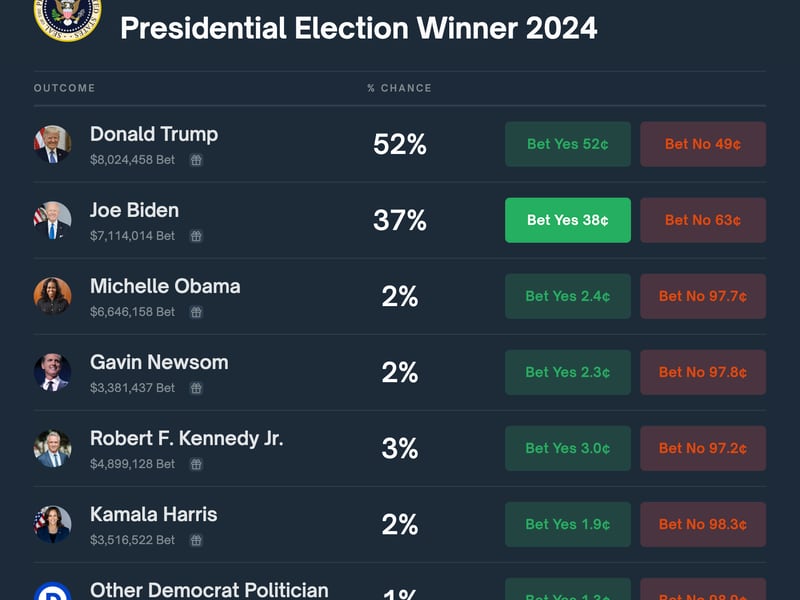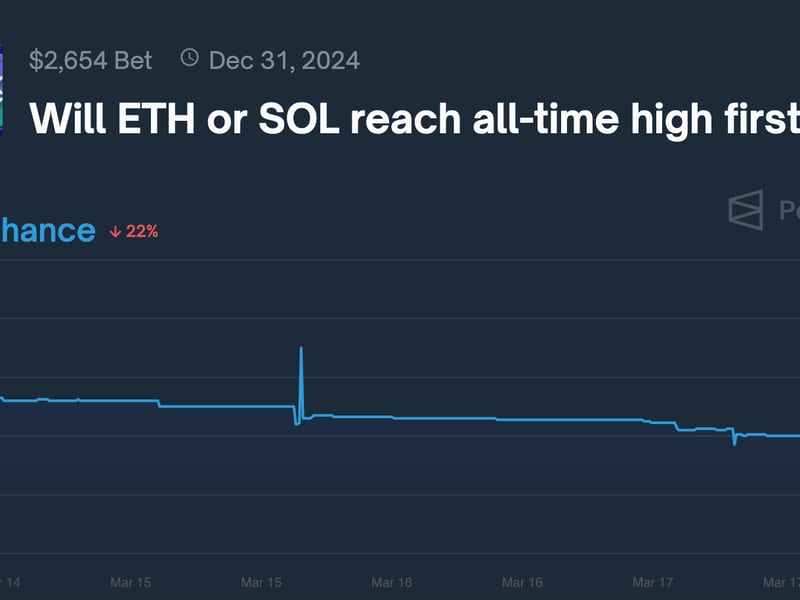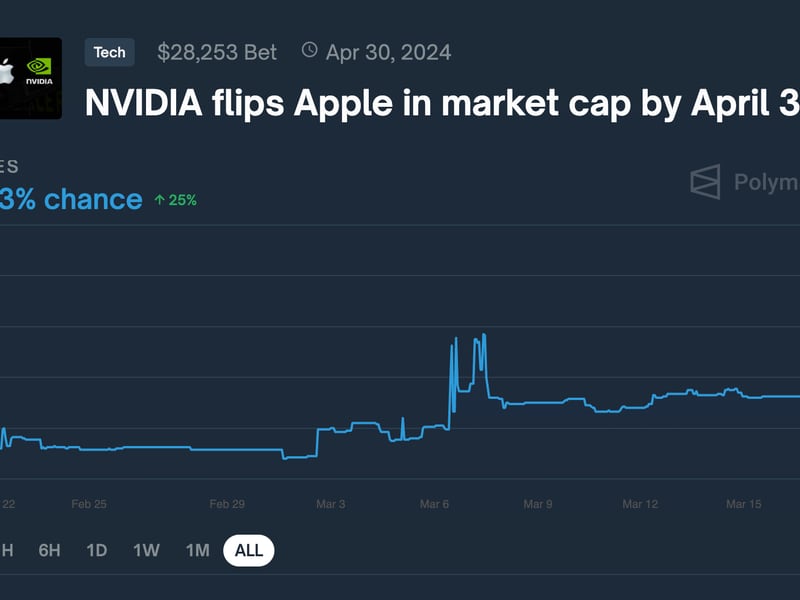Nearly $100M Wagered on U.S. Presidential Election on Polymarket

The averages of polls collected by polling aggregator 270toWin show the November race for the White House to be fairly competitive. Incumbent Joe Biden and former President Donald Trump look to be almost neck-in-neck, with Trump enjoying a 1.7 point lead — a number that's well within the margin of error for any poll.
Bettors on Polymarket are thinking differently, however, and don't see the race as being so competitive.
Nearly $100 million has been staked on the outcome of this election at the crypto-based platform, by far its largest market, and almost double the 2021 peak volume for all crypto-based prediction markets calculated by Bitwise Investments researchers. The wisdom of the crowd (or, at least, this crowd) is giving Trump a 52% chance, and Biden a 37% shot at victory.
Notice that these numbers don't round up to 100. That's because there's a long tail of candidates – declared and imaginary – that the crowd thinks might have a chance, as absurd as it might seem, at winning.

Michelle Obama. Gavin Newsom. Kamala Harris.
None of these three prominent Democrats has given any indication that they are running for president. Biden is the Democrats' official candidate. But there's still a belief among traders that Biden, with his advanced age and suspected cognitive decline, might pull out at the eleventh hour.
Making predictions for fun and profit
Prediction markets, despite hosting seemingly frivolous questions, provide alternative expert opinions with financially incentivized participants, potentially offering more accurate forecasts than fallible traditional polls.
They are also a method of hedging bets. Contracts asking a bettor to predict the outcome of a movie's opening weekend are a way to create a derivative on the stock of the studio; bets on the valuation of Reddit's IPO on the first day of trading offer a form of price discovery. Enron tried a primitive version of this during its heyday with its weather derivatives, but it was a lot less fun.
Prediction markets appear to finally be popping off in 2024, after years of being relegated to an academic hobbyhorse. Bitwise Investments researchers forecasted that "[m]ore than $100 million will be staked in prediction markets as they emerge as a new 'killer app' for crypto" in 2024. In the third month of the year, this number looks like it needs to be updated already.
Typically, prediction markets are framed as yes-or-no questions about verifiable outcomes (anything from court decisions to Grammy winners to celebrity peccadilloes – no, Polymarket, we are not linking to that one) within a set time period. Investors can buy "yes" shares or "no" shares; when the contract settles, each share pays out $1 if the prediction turns out to be correct, and zero if it's wrong.
Many prediction markets these days concern crypto-related outcomes, such as whether a given coin will hit an all-time high or do an airdrop by a certain date. As such, there may be alpha in them thar hills for investors who trade crypto in the spot market.
Eth vs Sol
In the winter of 2022, in the wreckage of FTX's collapse, Solana's {{SOL}} was down bad.
A centerpiece of the Alameda-Bankman-Fried universe of tokens, SOL plummeted far from the all-time high it hit of $258 in November 2021.
The DeFi Summer of 2021 pushed SOL to its first all-time high. Now 2024's Memecoin March looks to be giving it another go as the token tests $200.
The question put before Polymarket bettors is: will SOL or Ethereum's {{ETH}} pass its all-time high first?

Solana was built as an alternative to, at the time, a very expensive Ethereum network, which got many excited for the project. However, two and a half years of upgrades to Ethereum, culminating in the recent Dencun software update, have narrowed the gap in costs.
After spot bitcoin ETFs debuted this year in the U.S., many viewed an ether ETF as the next logical step and the market began to price this possibility in. However, questions linger about whether ether is a security in the eyes of U.S. regulators, weighing on the price. Singapore's QCP Capital has warned about a price correction coming to ether, and the digital asset hasn't been able to break past $4,000.
Yet on Polymarket, traders are signaling confidence that ether will hit an all-time high in 2024. Just not before SOL.
What will ETH's high for this year be? According to the newly launched crypto-related markets on the regulated U.S. platform Kalshi, it has a 74% chance of rising to $4,500 or above this year, a 57% chance for $5,000, and 42% odds of reaching $6,000.
Nvidia vs. Apple
A decade ago, Nvidia was a mid-sized chip designer that made graphics processing units (GPUs) that allowed gamers to enjoy better graphics every year, visual effects professionals to render their workloads faster, and computer-aided design software users to enjoy a smoother experience.
What a difference a decade makes.
Now the company's value is in the trillions of dollars as its GPUs are at the center of the AI revolution. Many market analysts have wondered if it's positioned as a contender to surpass tech giants like Microsoft and Apple.
A Polymarket contract asks bettors if and when that will happen.

Right now, the market is giving Nvidia a 33% chance of flipping Apple, the world's second most valuable company, by April 30.
Analysts have said that despite Nvidia's impressive growth and record-setting market cap jumps, the company's ability to challenge Apple's dominance remains uncertain, as it would require maintaining an exceptionally high price-to-earnings ratio and continuing unprecedented revenue growth in the face of potential market saturation and competition.
It looks like Polymarket investors agree with analysts – but that could change.








